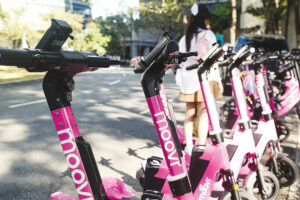By Miguel Hanz L. Antivola, Reporter
MOOVR PH wants to bring their services to more people and looks to technology to keep this goal affordable. — MOOVR PH
HOLDING the torch for an alternative mode of city transportation demands initiative, infrastructure, and sustainability, according to entrepreneur Anna Moncupa.
When Ms. Moncupa took her global business master’s in the United States and witnessed the pilot launch of Bird electric scooters and bicycles in 2017, she knew she wanted to bring certain competencies home and localize solutions for the Philippines.
Fast forward to 2020, Ms. Moncupa, founder and general manager of micro-electric mobility sharing service Moovr PH, established her startup after working with the Fort Bonifacio Development Corp., the master planner of Bonifacio Global City (BGC), from her logistics company Keepr Storage PH.
“It really was a passion project for our frontliners during the pandemic,” she said in an interview with BusinessWorld.
“A lot of nurses were coming in and out of BGC, and it was trying to bridge that gap in public transport at that time,” she added. “It evolved and grew into its own thing.”
Moovr began with regular manual bicycles and a small electric vehicle (EV) fleet of 20 scooters, which the company closely monitored to identify challenges and growth opportunities.
“I had to be careful because previous iterations of a sharing program didn’t last long,” she said.
“It was a lot of small steps for us in terms of the investments,” she added. “We did bicycles first because that required the least amount of capital and maintenance.”
“But we quadrupled the e-scooter fleet within a few months.”
To date, Moovr has improved and expanded its EV fleet to 310, from the previous 100 as of December last year, servicing BGC, the Makati central business district, and Filinvest Alabang.
The refreshed fleet has also introduced electric bicycles, with the Okai EB300 e-bikes and ES600 e-scooters, which both have swappable batteries and a maximum speed of 25 kilometers per hour.
Additionally, the platform currently has over 1,800 monthly active riders from its more than 231,000 user base, according to Ms. Moncupa. The rental rate for both e-bikes and e-scooters is P30 for 10 minutes.
PAIN POINTSMoovr saw a number of challenges upon introducing a new market for its services.
“Nothing else this solid really existed before us,” Ms. Moncupa said. “There was a bit of a learning curve between us and the riders that we both had to learn.”
She noted unauthorized parking, irresponsible riding, attempted cases of theft, and fleet availability as pain points for the company, especially at the onset, which Moovr is coming up with active campaigns to address.
“Some people want to rent it and not allow others to use it, but not get charged because they’re not on the pedal,” she said.
“But we also have to make the project commercially viable so we could keep doing it as a sustainable business model,” she added.
GROWTHHaving tripled its EV fleet availability the past month, Moovr is eyeing intercity transportation, yet only upon guaranteed infrastructure improvements such as protected bike lanes, according to Ms. Moncupa.
“We’re watching the e-bikes’ performance very closely because we have a feeling that it’s actually good for more sustainable transportation,” she said.
“The Philippine roads aren’t exactly built for cycling, and we’re looking for ways to address that,” she added.
“The goal is to really go outside further and further, but hopefully cities want it enough to provide infrastructure.”
“Our number one concern is the safety of our riders and pedestrians. If those conditions are met, then we can operate.”
Currently, Moovr is only working with private townships to grow operations, which Ms. Moncupa noted as an easier route given a dedicated department to accommodate the program, over that in local government units (LGUs).
“With LGUs, whether we like it or not, they may have more pressing concerns which may not exactly fit in the current agenda, which we understand,” she said.
“It’s tough with LGUs because on one hand, you know they want it. On the other, it’s hard to do it when there is no internal champion,” she added.
However, Moovr is also geared toward offering low-cost mobility while maintaining its cost structure to sustain operations.
“We’re trying to head toward the right direction,” she said on a green outlook for transportation in the metropolitan area.
“But it’s always a question of, ‘Are we able to execute this properly?’ ‘Can we take care of our cost structure enough to really make it inclusive?’” she added.
Ms. Moncupa noted that Moovr’s EV-centered operations are almost only privy to expensive cities and central business districts.
“We know we’re operating on a premium because we sort of have to,” she said. “We’re working toward bringing this on a scale where the cost is enough to really be used as a bona fide means of public transportation for everybody.”
“Technology and electricity are expensive, unfortunately,” she added. “I think it is every entrepreneur’s dream to offer it low enough and scale up.”
COMMUNITY BEYOND TECHNOLOGYInnovation through technology-driven solutions may look aspirational for entrepreneurs, yet Ms. Moncupa noted the importance of putting community first and center of any model.
“The innovation really happens outside of tech,” she said on recognizing potential even with limited resources and capital.
“We’re simply moving people, and tech enables us to do this at a lower cost,” she added. “But it’s not end-all, be-all.”
“What I learned is you need to serve a purpose because something like this cannot be purely commercial.”
Reception to feedback is both a challenge and opportunity for startups to audit itself and improve on lapses, according to Ms. Moncupa.
